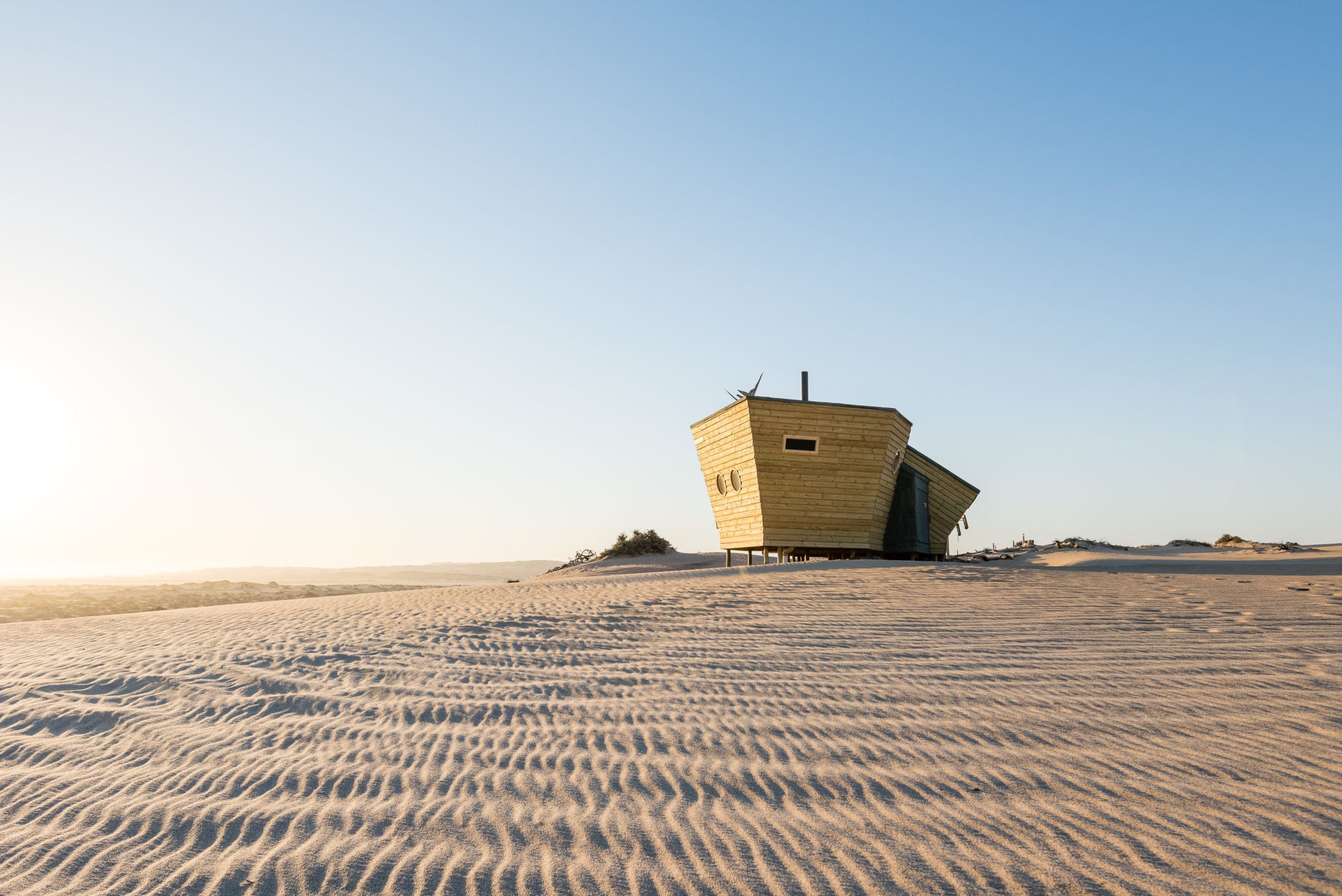Shipwreck Lodge
Skeleton Coast National Park, Namibia
Each of the 10 cabins at this remote lodge was designed to look like the many foundered vessels dotting the Namibian coastline. A joint venture between Journeys Namibia, Natural Selection and Trip Travel, the eco-friendly inn offers the only luxury accommodations in Skeleton Coast National Park, a protected desert habitat famed for its wind-sculpted sand dunes. Architect Nina Maritz constructed the solar-powered chalets in June 2018 using sustainably sourced timber, wood nails, and insulation made from recycled water bottles. Melanie van der Merwe, founder of Women Unleashed, took on the interiors, customizing the furniture and color scheme. (The mauve and dusty rose hues of the guest rooms were inspired by semi-precious stones found in the area, while the blue and gray tones mimic the wild Atlantic.) In the end, the lodge was built with almost no environmental impact, and per an agreement with the Ministry of Environment and Tourism, the cabins can easily be removed after a 25-year concession.
Getting There
If you’re feeling adventurous, rent a high-clearance 4WD vehicle and drive to Skeleton Coast National Park from a neighboring city. If you’re feeling sane, fly from the Namibian capital of Windhoek to Möwe Bay, where staffers will ferry you the rest of the way. The cabins are plunked somewhere between the Hoanib and Hoarusib rivers, AKA the middle of nowhere. If you insist on driving yourself, gas up in Terrace Bay and carry extra water.
Room to Book
Craving solitude? Lock in Lodge No. 1; it’s the farthest from the communal areas and therefore the most private. It also offers uninterrupted views of the landscape to the north. Otherwise, the accommodations are nearly identical: Each cabin has an en-suite toilet, shower and wash basin plus a wood-burning stove, writing desk, coffee-making station, faux fur throw, chess set, and private deck with knockout ocean views.
Design Highlight
Tempting as it may be to hole up in your own personal shipwreck, the lodge’s lounge and dining room are spectacular. Wall-to-wall windows and ample, comfy seating make these the perfect spots to nurse a sundowner cocktail or tuck into the chef’s catch-of-the-day dinner. Enamel dishes and vintage silverware give the lodge a homey feel, while Otjomuise-woven baskets and specially commissioned works by Namibian artists lend some soulful character.
Good to Know
Because the lodge is so isolated, you’ll need to arrange excursions like fishing, birdwatching and quad biking through the hotel. To get even farther afield, hop in a 4WD bound for Clay Castles, a remarkable geological formation flanking the Hoarusib River, or book a full day’s outing to see the seal colony in Möwe Bay, an abandoned Westies diamond mine, and the remnants of the famed Karimona and Suiderkus shipwrecks.
Q+A with Nina Maritz
Architect
How did the natural landscape of the Skeleton Coast influence your architecture?
The location and history inspired the idea of shipwreck buildings. The dune site, with its strong southerly prevailing winds, inspired the form of a ship’s bow facing into the wind. The subtle changing colors of the landscape also had a strong impact on the color scheme of the buildings and interiors.
Do you have a favorite space here?
I love the quietness of the cabin bedrooms. With the sound of the wind around the building, it’s like sleeping snugly in a wooden boat on the waves. I could stay there for days, just looking at the changing landscape and sky, especially the opalescent colors of the evenings.
Any memorable animal encounters while building Shipwreck Lodge?
Waking up in a camping tent and seeing lion and elephant tracks nearby is quite an experience! We also saw springbok, seals, jackals and a rare brown hyena loping off to the sea.
What are your travel essentials?
A BPA-free water bottle, lens cleaner for my eyeglasses (since Namibia can be quite dusty), and my notebook with wipeable paper and Pilot FriXion pens. I love jotting down notes and sketches of my visits, then photographing the pages before wiping them clean.







